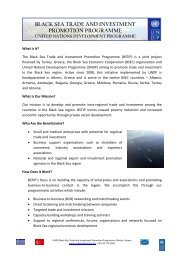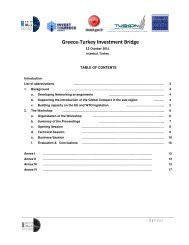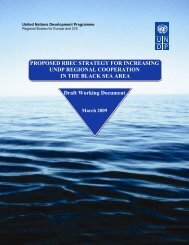Tradeflow Study - UNDP Black Sea Trade and Investment Promotion ...
Tradeflow Study - UNDP Black Sea Trade and Investment Promotion ...
Tradeflow Study - UNDP Black Sea Trade and Investment Promotion ...
Create successful ePaper yourself
Turn your PDF publications into a flip-book with our unique Google optimized e-Paper software.
II.3. <strong>Trade</strong> preferences in BSEC<br />
The Organization of the <strong>Black</strong> <strong>Sea</strong> Economic Cooperation has promoted a departure from<br />
previously protectionist <strong>and</strong> import-substitution policies existing in the region into a more open<br />
outward-looking export oriented paradigm. Countries in the region have undergone structural<br />
adjustment programmes, gradually moved to a market economy <strong>and</strong> encouraged international<br />
competitiveness. By analysing the tariff structure of the region, several characteristics can be<br />
highlighted to evaluate the level of openness <strong>and</strong> attractiveness for trade <strong>and</strong> investment in<br />
the region. In particular, with trade integration efforts, barriers to trade existing between<br />
member countries (tariff <strong>and</strong> non-tariff) are expected to fall while those with the outside world<br />
are expected to remain constant (or phased down in line with multilateral trade negotiations).<br />
There is currently no common external tariff for the region. The BSEC envisages the free flow<br />
of goods <strong>and</strong> services, factors of production <strong>and</strong> capital, <strong>and</strong> encourages interaction between<br />
Member States <strong>and</strong> private sector organizations, but it does not aim to form a customs union<br />
at this stage. Three countries (Greece, Bulgaria <strong>and</strong> Romania) belong to the European Union<br />
<strong>and</strong> have therefore adopted the same tariff structure as the EU. The other countries apply<br />
their own individual tariff rates.<br />
The current tariff structure is quite different from one country to another. The dispersion for<br />
the Most Favoured Nation (MFN) tariff rates can range from 0 percent to 1,000 percent <strong>and</strong><br />
the differences between the countries’ tariff structures are sometimes very pronounced. For<br />
instance, Armenia has an MFN rate of 1,000 percent on cigars, cheroots <strong>and</strong> cigarillos<br />
containing tobacco, while other countries in BSEC apply a tariff rate between 0 percent <strong>and</strong><br />
60 percent.<br />
The regional economic cooperation has adopted a strategy which allows Member States to<br />
progress at different speeds into the liberalisation process, <strong>and</strong> permit them to have bilateral<br />
preferences with partners that share common interests in specific sectors. This approach has<br />
the advantage of conferring flexibility for member states <strong>and</strong> also to formulate independently<br />
from others their trade policy. However, this also can lead to trade deviation effects <strong>and</strong><br />
inefficiencies.<br />
Figure 4 provides a summary of the principal tariff peaks which exist in the region <strong>and</strong> the<br />
dispersion between the highest <strong>and</strong> lowest tariff for a given good across BSEC. Tariffs have<br />
sometimes been converted from specific tariffs to ad-valorem equivalent tariffs in order to<br />
37/135






